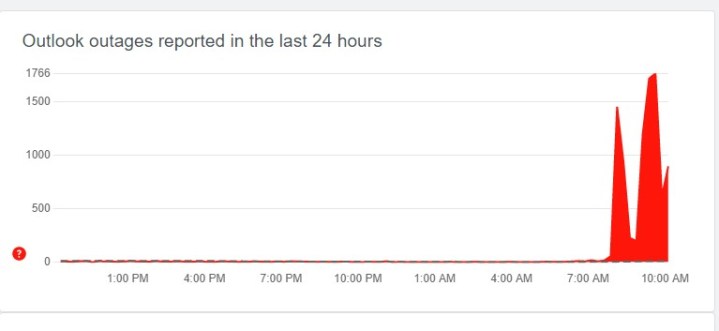Outlook servers are back online after experiencing an extended outage on Monday morning. The Office service health page provided an update shortly after 11 a.m. PT noting that all services should be operational.
Microsoft confirmed the outage early Monday morning in a tweet, pushing Outlook administrators to the EX401976 and OL401977 codes for information. Although the issue didn’t affect all users, it was still a significant outage. Down Detector, which tracks outages for online services, received thousands of user reports centered around Outlook starting at around 6 a.m. PT.

According to Microsoft, the issue stemmed from “a network router [that] was performing below acceptable thresholds.” After monitoring the issue over an extended period, Microsoft has confirmed that it’s resolved. Originally, users reported several different issues with Outlook. Some couldn’t load their inbox at all, others experienced decreased performance, and some weren’t receiving new messages in their inbox.
Now that the dust is settled, we have a clearer view into what happened. Microsoft says that the issue mostly affected users in the Northeastern U.S. and surrounding regions, suggesting the outage was caused by decreased performance at one of Microsoft’s regional data centers.
In addition to Outlook, Down Detector also shows hundreds of reports for Microsoft’s website, as well as Office 365 services. These services should be back online as they share the same infrastructure as Outlook, but it’s possible Microsoft is addressing them separately.
Although Microsoft says the issue is fixed, it’s possible that Outlook will experience some minor issues over the course of the day. If you need to send an urgent email, you might want to switch to a different service in the meantime — and if you want to stay away permanently, you can read our guide on how to delete your Outlook account.
It’s not clear how many users were impacted, but reports from Down Detector suggest it was widespread. We’ve confirmed Outlook is up and running on our end, but Microsoft still suggests admins keep an eye on the EX401976 and OL401977 in the admin center for updates and more information.
Now that Outlook servers are back online, make sure to check out our three tricks to clean up your Outlook inbox. We also have a roundup of Outlook tips that can help you move around the client faster and access features you may not have known about.



